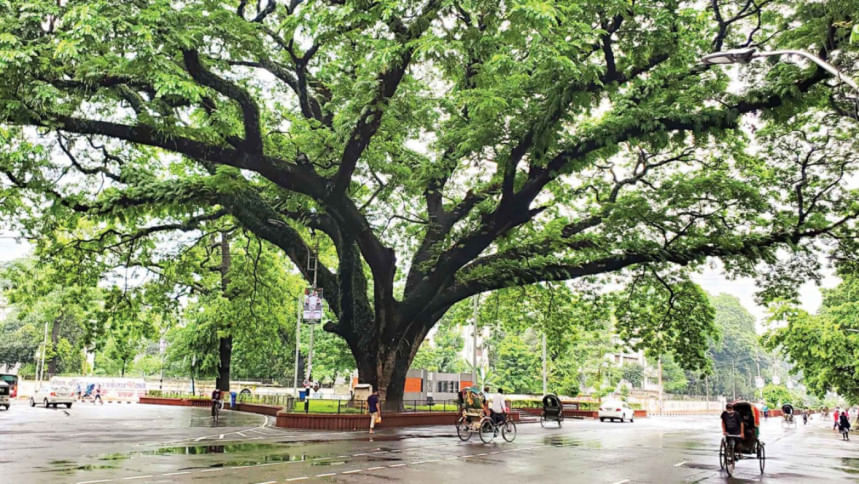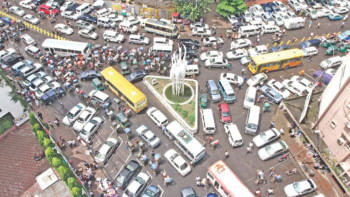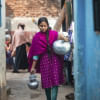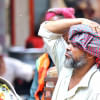Trees can be the cheapest anti-heat, anti-anger infrastructure

I have lived through enough summers in Dhaka to know that the city's heat is no longer merely a discomfort but an aggression. It presses against the body with a weight that drains patience and shortens the distance between thought and outburst. I feel it in the way tempers flare over small inconveniences, in the way conversations are cut short, and in the way people move with an urgency born not of efficiency but of escape. In psychoanalytic terms, the heat pushes us into a state of heightened arousal, where the ego's capacity to mediate between instinct and reason thins to a fragile thread.
It is in this climate that I have come to see trees not as decorative indulgences but as essential instruments of public policy. A tree is a cooling device for the body, but it is also a cooling device for the mind. The shade beneath its canopy is a holding environment, a psychic buffer that interrupts the unrelenting exposure of both skin and nerves. I think of the banyans and rain trees where I have stood not to admire a view but to reclaim a part of myself from the oppressive immediacy of heat.
In my research, I have often described holding environments in architecture—spaces that can contain emotional intensity without amplifying it—and I realise now that trees do this in the open city. They slow the pace of movement, soften the glare, and create microclimates where people can linger without irritation. Without them, the public realm becomes an arena of collisions: pavements without shelter, intersections that feel like furnace mouths, plazas that blind and exhaust. These conditions are not neutral; they prime us for confrontation.
The argument for trees is not only psychological but economic. They are the cheapest infrastructure we could invest in to cool a city. They require no imported technology, no energy source, and no specialised maintenance once established. A single planting, if protected, can serve for decades, lowering surface temperatures, filtering polluted air, absorbing noise, and offering a spatial gentleness that no concrete structure can match.
Yet in Dhaka, trees are treated as expendable. They are cut down for road-widening with no plan for replacement. Beautification projects too often strip the streets bare in the name of openness. I sometimes think our planning institutions carry an unconscious hostility towards softness, as if vulnerability itself must be erased from the city's fabric. The result is an urban landscape stripped of mediating forms, where there is no gradual transition from the harshness of sun and noise to the more bearable conditions of shade and quiet. It is simply the raw confrontation of body with environment.
I often imagine how different the city's atmosphere could be if trees were restored as anchors of daily life. A shaded lane would slow the tempo of movement without stalling it, soften the soundscape, and allow a more measured rhythm of interaction. It would offer a place to pause that is neither inside a shop nor under a paid roof but open, free, and shared. This is a form of spatial psychoanalysis: creating conditions where the urban subject is not forced into polarities of withdrawal or attack but can inhabit the subtle in-betweens.
If trees are incorporated in public policy, they could be legislated into permanence: minimum canopy-cover requirements for every kilometre of road; compulsory planting as part of any building permit; penalties for felling without replacement; and an annual audit of shade deficits alongside air-quality reports. Most of all, there can be a planning culture in which trees are not the leftovers of design but one of its first lines—an essential threshold between the exposed violence of the city and the softer tissue of its people.
The psychoanalytic lens helps me understand why this matters beyond climate adaptation. A shaded street is a street where the superego—our internalised sense of civility—stands a better chance against the irritability of the id when overheated. The tree canopy becomes a quiet moral structure, regulating mood before it spills into violence. In this way, environmental planning, urban design and civic ethics meet in the most ordinary of forms.
We cannot air-condition our way out of the heat crisis, and we cannot police our way out of public aggression. Both are symptoms of a deeper estrangement between body and environment. Planting trees is environmental work, but it is also civic repair. It is the restoration of the holding environments that makes public life liveable for both body and mind. If heat has become our national season, then shade must be our national policy. And if we can accept that a tree is not a luxury but the simplest and most democratic form of public peacekeeping we have, then perhaps we can begin to replant not only our streets but also our capacity to live together without the constant abrasion of climate and temper.
Maruf Ahmed is an architect and lecturer of the architecture department at Khulna University of Engineering & Technology (KUET).
Views expressed in this article are the author's own.
Follow The Daily Star Opinion on Facebook for the latest opinions, commentaries and analyses by experts and professionals. To contribute your article or letter to The Daily Star Opinion, see our guidelines for submission.

 For all latest news, follow The Daily Star's Google News channel.
For all latest news, follow The Daily Star's Google News channel. 









Comments